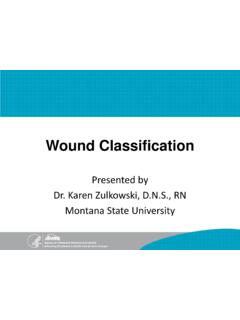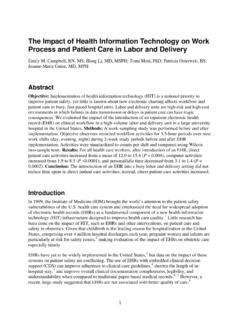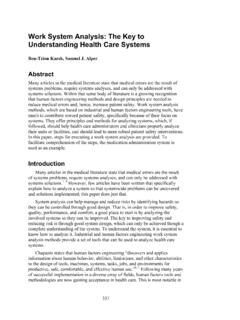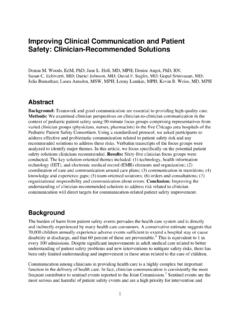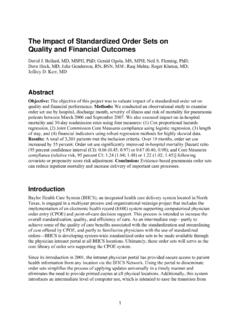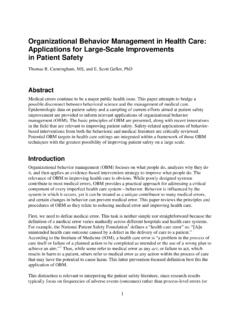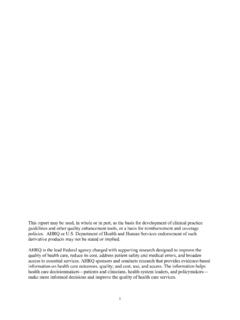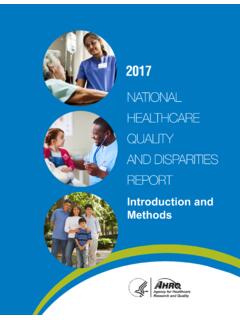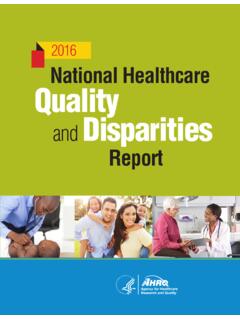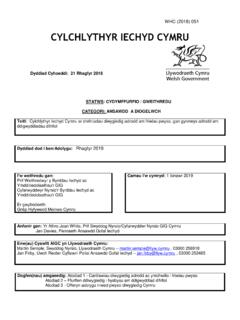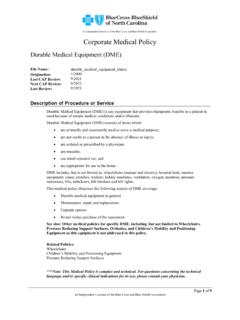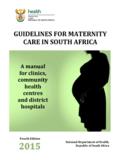Transcription of Return on Investment Tool
1 Toolkit for Using the AHRQ Quality Indicators How To Improve hospital Quality and Safety i Tool Return on Investment Estimation What is the purpose of this tool? When your hospital invests in a new program, quality improvement intervention, or technology, leaders often need to know what kind of financial Return the Investment will yield. A Return on Investment (ROI) analysis is a way to calculate your net financial gains (or losses), taking into account all the resources invested and all the amounts gained through increased revenue, reduced costs, or both. This tool provides a step-by-step method for calculating the ROI for a new set of actions implemented to improve performance on one or more of the AHRQ Quality Indicators (QIs). It also provides a case study of ROI calculated by a hospital for implementation of computerized physician order entry (CPOE). Who are the target audiences?
2 Potential users of this tool include individuals who will contribute to ROI calculations, which may include hospital or health system financial, quality, or analytic staff, as well as statisticians, data analysts, and programmers. How can the tool help you? Examining anticipated financial outcome data can help hospital and health system leadership make more informed decisions when prioritizing resources for quality improvement initiatives. ROI also can be used as an evaluation tool to examine the cost of an initiative after implementation. Using ROI as a planning tool. During the planning process that precedes implementation of improvement actions, projected ROI can be used to estimate how the planned intervention will affect revenue and operating costs and to adjust the intervention to better optimize both quality and financial performance. In addition, ROI can be used to show how long it will take for an intervention to break even that is, for the returns of the practice improvement to offset the upfront and ongoing implementation costs.
3 This analysis can be done using data from the literature. Using ROI as an evaluation tool. Actual ROI can be calculated after a practice improvement has been implemented to assess its value and inform decisions on future improvement actions. This analysis can be done using actual data from your hospital . How does this tool relate to other tools in the Toolkit? The ROI tool is used as a planning tool to develop cost and Return information for use in setting priorities for improvements on the AHRQ QIs, with the results of these analyses applied in the Prioritization Matrix (Tool ). It also can be used as an evaluation tool along with the Project Evaluation and Debriefing tool (Tool ) to assess financial effects of the improvements implemented. Toolkit for Using the AHRQ Quality Indicators How To Improve hospital Quality and Safety 1 Tool Calculating and Interpreting Return on Investment (ROI) An ROI is calculated as the ratio of two financial estimates: ROI = Net financial returns from improvement actions / Financial Investment in improvement actions Where the numerator and denominator of this ratio are defined as follows: Net financial returns from improvement actions.
4 The financial gains from the implementation of the improvement actions, which are generated by net changes in quality, efficiency, and utilization of services, or in payments for those services. Financial i nvestment in improvement actions. The costs of developing and operating the improvement actions. How does ROI differ from cost-effectiveness analysis (CEA)? CEA and ROI share some common features, but they differ in the effects that are addressed. Both ROI and CEA are expressed as ratios, and they use the same dollar amounts for improvement Investment costs. ROI shows how much financial gain a hospital or health system can obtain from each dollar it invests in a quality improvement program, while the results of a CEA indicate the costs to a hospital for each unit of effectiveness it achieves through quality improvement actions, such as the costs for each adverse event avoided.
5 These differences are reflected in the formulas used to calculate the ratios. ROI = Financial gains / Improvement Investment costs CEA = Improvement Investment costs / Effectiveness The step-by-step procedure described here can be used to perform ROI calculations to assess your financial Return on improvement actions that you either are planning or have implemented. Additional information that may be useful to consider is provided in the section titled Additional Guidance for Effective ROI Calculation. Throughout this document, the term improvement actions refers to any hospital program or initiative that aims to improve the quality or safety of hospital inpatient care, which may include a focus on improving performance on the AHRQ QIs. Step 1. Determine the Basic ROI Design Before you start to calculate ROI for any given improvement actions, you need to make four design decisions that will structure your approach to the analysis: 1.
6 Define the scope of services affected by the improvement actions. Some actions will be limited to making improvements in one hospital unit ( , the emergency department), and others will have a broader scope ( , across all nursing units). Carefully define the scope of services to be included in the ROI calculation, and ensure that financial estimates are specifically related to that scope of services. 2. Define the timeline for implementation of improvement actions. When implementing improvement actions in your hospital , those actions will occur over a period that could be Toolkit for Using the AHRQ Quality Indicators How To Improve hospital Quality and Safety 2 Tool as short as a few months or as long as years. The ROI analysis needs to capture when those actions change the hospital s operating procedures over time, to estimate both the implementation costs and the financial effects of improvement actions.
7 If changes occur over years, you will need to adjust the estimates for inflation and discount future costs and revenues. 3. Define the comparison group. To estimate the numerator (net Return portion) for the ROI ratio, you need to compare the hospital s finances under two conditions with the improvement actions implemented and without them. Typically, this will be a comparison over time, with the before condition being the service processes before improvement actions, and the after condition the service processes after implementation. Other possible comparisons are comparisons across units within the same hospital , or across hospitals. If you use other units or hospitals as comparisons, be sure to choose comparison groups that have similar characteristics to your service entity except that they did not implement the improvement actions. 4. Capture complete information on financial contributors.
8 To obtain the most accurate ROI estimate, you will need to identify and quantify as many of the financial contributors as possible for both the numerator and denominator of the ROI formula. For a planning phase ROI, you will work with your best estimates of improvement action costs and of the components of net returns. For a postimplementation ROI, you will have actual data from your financial system on those contributors. Step 2. Calculate the Return on Investment To calculate the ROI for the improvement actions, you will develop estimates for both the numerator and denominator of the ROI ratio: Net returns from the improvement actions (the ROI ratio numerator) Implementation costs (the ROI ratio denominator) Worksheets are provided here for your use in developing these estimates. Worksheet 1 can be used to estimate the costs for your Investment in the improvement actions, and Worksheet 2 can be used to estimate the net returns from those actions.
9 Considerations When Calculating Implementation Costs. Instructions for completing Worksheet 1 are provided at the top of the worksheet. You will use the same methods to estimate these costs that you would use for program budgeting or financial accounting of actual costs. The grand total of estimated implementation costs calculated in Worksheet 1 is the ROI denominator. The costs involved in implementing improvement actions may be incurred at different stages of the implementation process. Your hospital s financial staff will need to estimate these costs at all stages of the program from start to end if using the ROI tool for planning. If you use the ROI tool for evaluation purposes, you will need to track costs throughout implementation. Table 1 shows example categories of costs at each stage of program planning, implementation, and maintenance (see descriptions of these components in Appendix I).
10 These broad categories are meant as suggestions. Not all costs included will apply to all types of programs or quality improvement initiatives. In addition, you may identify other relevant costs that should be included but are not shown here. Toolkit for Using the AHRQ Quality Indicators How To Improve hospital Quality and Safety 3 Tool Table 1. Categories of Costs Incurred at Different Stages of Implementing a Practice or Quality Improvement Program Stages of the Improvement Actions Cost Category Planning and Development Training Startup Ongoing Operation, Monitoring, and Maintenance Shutdown Personnel X X X X X Supplies X X X X X Equipment X X Training X X X X Information systems X X X Outreach and communication X X X External consultant costs X X X Considerations for Calculating Net Return . Instructions for completing Worksheet 2 are provided at the top of the worksheet.
